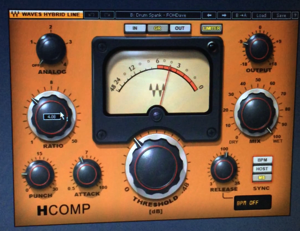
QuickTip: Drum Spanking

Not too long ago I was chatting with some engineers, and the topic of parallel compression came up. Most of the guys I was talking with seemed to have abandoned it. Nothing wrong with that, however, based on the way they were talking about it made me wonder if everyone quite understands what parallel compression can really do and how to make it work for fun and profit.
I think I’ve talked about this in the past so I’ll kind of summarize a bit. For me, parallel compression on drums is part of my drum sound. Basically, I feel like it thickens them up and gives them added weight and power in the mix. It can also be used to get them louder without substantially raising the peaks; in other words, it can save headroom in the system. It can also help bring out some of the subtlety in the playing without adding the side effects of compression. In a way it’s kind of a have your cake and eat it, too thing for me.
The traditionally talked about way of doing this that you’ll find on forums/videos/etc. is to take your drums(preferably minus cymbals) and send them to a couple of busses or groups. You leave one group clean or clean-ish and stick a compressor on the other one. Then you compress the snot out of the compressed/spanked group and blend it in with your natural drums.
So that’s one approach, and I guess it can work, but it never gave me what I was looking for with this.
I really owe this stuff all to Robert Scovill because he was the first engineer who opened up my ears on what this could do and a starting point to make it work. One of the biggest things I took away was to not compress the compressed buss so much. To this day, I still rarely use more than 6 dB of gain reduction on my compressed buss, but I’m more often around 3-4 dB or so.
If you’re trying to play with this, and you’re not sure about how to set it up initially, try this:
Turn off your uncompressed buss so all you hear is your “spanked” drums. Now just dial in some compression on them so they’re compressed a bit. You can go a little fast on the attack to take off the transient a bit, and then keep the release medium to fast to keep your punch. I’d recommend starting with a 4:1 ratio or so. You don’t need to hammer the drums, though. Just compress them a bit so you actually hear them as sounding compressed.
Once you get this dialed in, take the group out of the mix and go back to just your regular drums. Mix your regular drums in to about where you’d like them to sit in the mix, and then feather your compressed buss into the mix. As you bring in that compressed bus, your drums should gain authority in the mix.
“But now my drums are too loud!“
Well, if they’re a bit too loud, pull both of your groups back a bit to bring the overall level down, but before you do that go listen to some old Celine Dion stuff.
I’m being serious.
Celine.
Dion.
Actually, you know what? I’ll save you a trip. Here’s some Celine embedded right here courtesy of Spotify:
Now, if the drums in a Celine Dion mix are louder than the drums in your mix, I think you can turn your drums up.
Seriously.
Here’s a bonus tip. A popular design in a lot of modern compressors and especially plugin compressors is a wet/dry knob. The idea behind this is now you can do parallel compression without taking up an extra buss and then easily blend between the compressed and uncompressed. It’s definitely a cool feature to have, but I don’t think you should use that for this.
Why?
Well, what if you want to use some kind of vintage-y EQ with fairly wide filters to apply EQ to only the compressed drums? Maybe you want to bump 5k a little and maybe something below 100Hz. How would you do that if you use the wet/dry knob? Well, you wouldn’t be able to do it if you wanted to.

 Previous Post
Previous Post Next Post
Next Post





